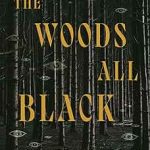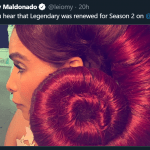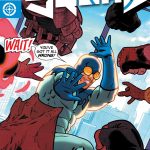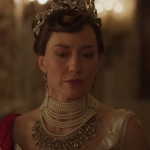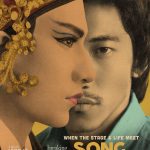The Textile of Grief: An Interview With Ashanti Fortson, Creator of “Leaf Lace”
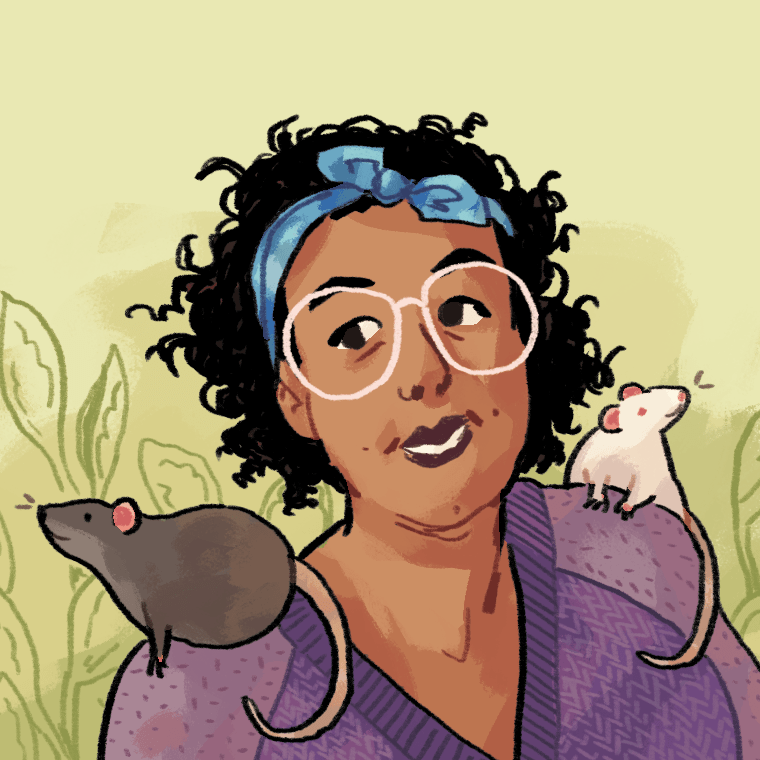
Ashanti Fortson, notable creator of several comics like Leaf Lace and the forthcoming graphic novel Cress & Petra, talks about their creative process and inspiration behind their work.
A while ago, I spotlighted Ashanti Fortson and reviewed their new short comic Leaf Lace, a narrative about grief and what it means to live. It’s my pleasure to have her here to share the process and inspiration behind her storytelling and art.
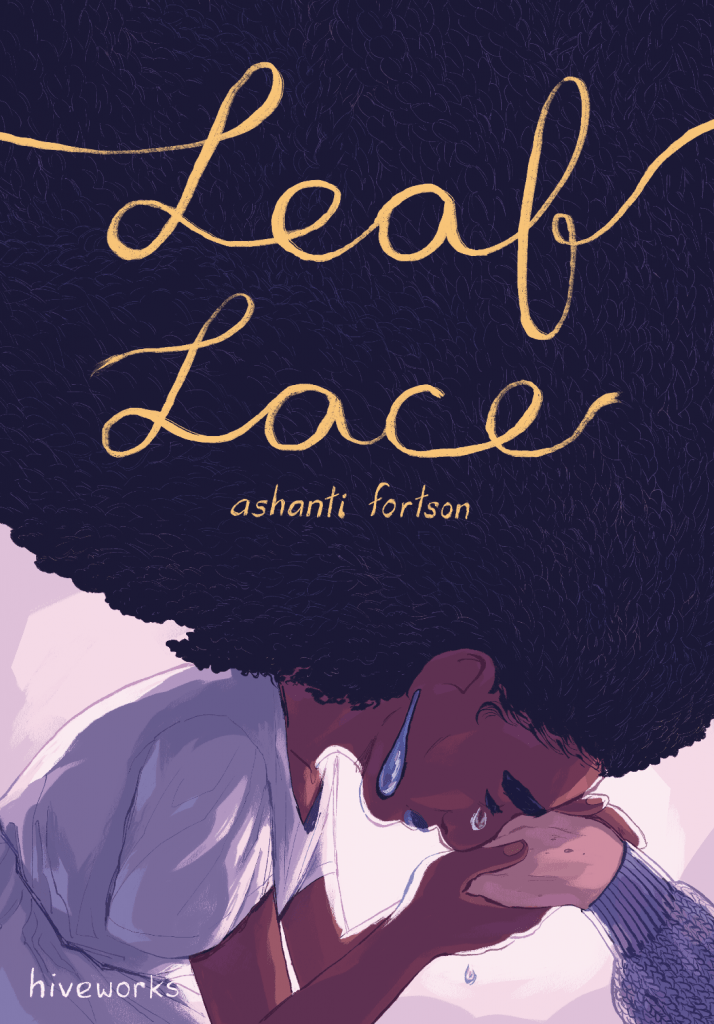
The Geekiary: Thank you so much for taking the time to be here! Let’s start by introducing yourself!
Ashanti Fortson: Hi, thanks so much for having me! I’m Ashanti Fortson, a cartoonist, illustrator, comics editor, and illustration professor based in Baltimore. It’s hard to link a unifying theme within my body of work, as I’m interested in exploring different topics with each project, but much of it is speculative fiction that engages with vulnerability. I like making work that is reflective, lush, tender-hearted, and emotionally impactful. I’m also a big fan of comic essays!
TG: Leaf Lace is such an emotional journey. Your art evokes the atmosphere and character dynamics so effortlessly. What started the idea for this gorgeous comic? What inspired it?
Ashanti: Thank you! Leaf Lace spent a long time marinating before I actually made it, so there’s a lot that went into it. Part of the inspiration for the comic was my own emotional processing of love and the loss that comes with it. I spent quite a bit of time thinking of “anticipatory grief,” where one grieves a loved one before they have actually passed – perhaps even before their passing is realistic or feasible.
Anticipatory grief, in my thoughts, revealed itself as a defense mechanism: one does not want to experience the undiluted pain of losing a loved one, so one prepares themself beforehand. It belies a misunderstanding of death itself, which is inescapable both in its material reality and in its emotional reality. The ideas of anti-grief defense mechanisms and the desperation of trying to “bargain” with death and its effects became the conceptual core of Leaf Lace.
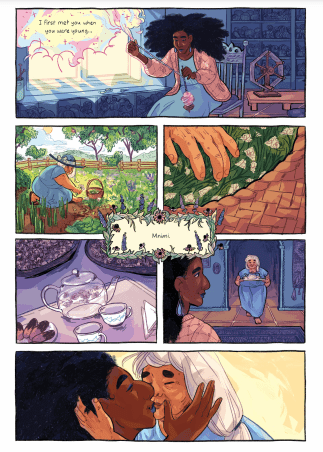
There’s another facet to it, though, which manifests in the visual. A massive inspiration in my work overall is textile art: embroidery, knitting, weaving, etc. As I was thinking about grief, I began to understand it through textiles. Grief throughout life, like knitting or embroidery, is an accumulation. One after the other, after the other, after the other.
A shawl is an accumulation of stitches, culminating in a finished piece. Anticipatory grieving is an accumulation of suffering, culminating in the stark reality of death. Likewise, love is an accumulation of memory, culminating in a life worth living. This is what became Leaf Lace.
TG: What is your creative process?
Ashanti: This is a big question! My comics process is pretty multi-faceted, and tends to be front-heavy rather than back-heavy. By that, I mean that I do almost all of the thinking, planning, and editing as soon as possible in the process – I don’t like to waste any work, so I want to get it right the first time I execute my ideas! On a more concrete level, my process is loosely segmented into three stages: conceptualizing, writing, and executing.
The conceptualizing stage is basically what I talked about regarding the inspiration for Leaf Lace! It’s the stage where I work through what I want to achieve with the project, what I want to explore or communicate, and how I want to express the ideas I’m working with. Most of the time, this stage is entirely in my head, and I try not to share my thoughts with other people throughout this stage. If I do talk about a project during this stage, I always sound very clumsy! So I just let the vegetables simmer until they’re ready for the writing stage.
When the ideas are all ready, I start outlining the story. My outlines are very detailed. This is where I try to put the most work; if possible, I want to have the outline rock-solid before scripting. I outline everything I know about the story, both narratively and visually. I include (and emphasize) emotional beats, not just plot beats. Then comes editing! Whether I’m working with an editor or not, I’ll edit my outline thoroughly. The more issues I resolve in my outline, the less work I have to do later.
The next part of the writing process is scripting, which is the easiest and fastest step. I’m mostly working out dialogue and page-to-page pacing here. I include imagery descriptions for myself as well, but it’s all preliminary. The next writing step is thumbnailing. I consider this the most crucial part of writing a comic. The script provides the measurements for thumbnailing, which is the foundation and structure of the house. I’m thorough in my thumbnails as well; ideally, nothing makes it to pencils unless it’s totally solid on compositional, visual, spatial, and narrative levels.
The next part of writing is penciling the comic…which is technically drawing the comic! But in comics, drawing is writing. Penciling the comic is where I handle more fine-tuned parts of writing: expressions, body language, design, detail. The last part of writing is color design, where I lay out all of the penciled pages at a small scale and block in rough colors for each page and panel. That lets me make writing decisions about atmosphere, mood, character relationships, emotions, and impact. It also lets me resolve any visual problems within the “color story” of the narrative. (Contrast problems, too bright to print, etc.) These are the last stages where I make any significant edits; from here on, it’s just final tweaks.
The third stage is executing, which is bringing the penciled pages to the final stage. My process for that is an inks/line work and lettering step, then a final coloring step. This stage involves the least conceptualizing, planning, and editing, but it’s by far the most time-consuming and laborious stage. Then the comic is done! Finally!
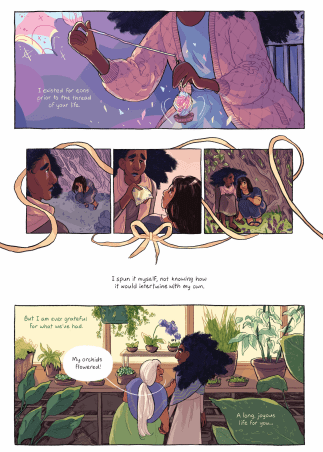
TG: What is one piece of advice you’d provide to a creative who is looking to hone their craft and get their work out there?
Ashanti: If I could only give one piece of advice, it’d be to practice thoughtfulness and intentionality in your work. That involves asking yourself lots of questions, interrogating your intentions, and self-reflecting when it comes to your craft. What are your goals for this? What do you want? How do you get there? Thoughtful, intentional practice is a thousand times more effective than “automatic” practice. Always ask yourself questions, and figure out what your answers are.
Leaf Lace is available to buy at Hivemill.
Learn more about Ashanti Fortson and their other projects here.
You can find more about Black creators and their works on The Geekiary here.
Author: Bradda M.
Bradda M. currently lives in Virginia. He teaches ESOL (English to Speakers of Other Languages) at a public school and spends his free time reading and watching movies each night with his partner. For The Geekiary, he writes about webcomics and SFF media.
Help support independent journalism. Subscribe to our Patreon.
Copyright © The Geekiary
Do not copy our content in whole to other websites. If you are reading this anywhere besides TheGeekiary.com, it has been stolen.Read our


